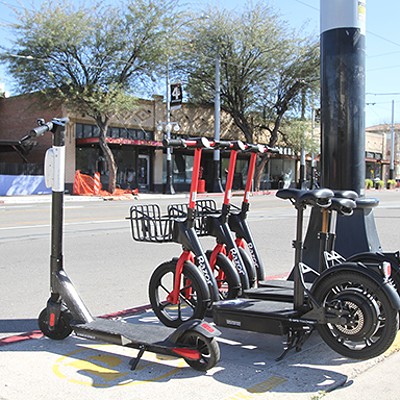At least one has found the search expensive, time consuming and frustrating.
Located on the northwest corner of Campbell Avenue and Grant Road, the Samos neighborhood has to contend with both rush-hour cut-through drivers avoiding the reversible lane on Grant Road and the hundreds of commuters hurrying to and from Salpointe High School. A few speed humps were tried to slow things down, but not all residents considered them satisfactory.
Two years ago, with the projected widening of the Grant/Campbell intersection in the planning stages, some neighbors decided to address the traffic problem. Using their own money, along with funds donated by the high school, they designed and constructed an initial traffic circle.
Pleased with the result, they received a $3,000 grant from the PRO Neighborhoods program. Combining those funds with contributions, Samos resident and civil engineer Henry Jacobson designed three new circles, which were built with contractor help and completed by another local homeowner for about $1,200 each.
In the fall of 2002, their City Council representative, Kathleen Dunbar, also awarded the neighborhood association $50,000 of Back to Basics money for additional traffic mitigation measures. The program, intended to fund physical improvements addressing critical community day-to-day issues, (See "Getting Back to Basics," July 31) seemed to be a real plus for the Samos area.
But that's when things got complicated.
To maximize its use, Jacobson and others in the area wanted to channel the Back to Basics funds through a nonprofit organization instead of having the city administer the money. They thought this would allow residents to design and help construct the new circles much like the previous four.
That was an important consideration, since an overall traffic mitigation plan was being developed for the neighborhood. It included five additional circles, several entry islands and other improvements.
It was an ambitious goal, especially because the estimated cost of each new circle is at least $6,000-$8,000--at least five times the cost of the previous circles--if built under the normal Back to Basics procedure. That process requires professionally prepared plans, public bidding of the work and implementation by a licensed contractor. In addition, the program usually spends 25 percent or so of the funds for administration and design costs. Given that, the Samos area was looking at not being able to install its entire traffic plan if it followed the regular process.
The idea of funneling the funds through a nonprofit organization to lower costs was discussed by neighborhood representatives and city officials earlier this year. But after considering it, the possibility was rejected by City Hall.
"We want to make sure improvements are built the right way by qualified people," says Mike Rankin, of the City Attorney's office. Stressing that Back to Basics work has to be publicly put out to bid, he said the city preferred to administer the projects itself and go through the normal procurement process instead of having to monitor a nonprofit group's effort.
While admitting this experience has been frustrating and knowing that because of its financial situation the City Council has had to reduce its Back to Basics allocations by 50 percent, Dunbar says they have to play by the rules.
"That's the system in place, and that's how the bureaucracy works," she says.
She also thinks the Samos neighborhood is unique in having professionals capable of designing and implementing projects on a volunteer basis--and that some areas in her ward wouldn't be able to do the same.
Tres English believes other neighborhoods wanting to install traffic circles should look elsewhere besides the Back to Basics program. English, who was instrumental in the construction of a circle in the San Clemente neighborhood in 1988, also hopes the city will amend its current requirement of mandating a concrete collar around each one. Assuming that happens, he thinks the cost of a do-it-yourself project should not exceed $1,000.
"Neighborhoods should build them themselves and pay for them themselves," English says. "The major advantage is they don't have to deal with the city's huge procedural problems, and local residents have a real stake in the circles. It's critical to get neighborhood people together to build and maintain them."
While he is frustrated by the process, Jacobson, who is currently president of the neighborhood association, is pleased with receiving the Back to Basics money, and he says the Samos project is slowly moving forward. But to reduce costs, since the future circles will be five to seven times as expensive as those already installed, he indicates that whatever can be afforded will not have landscaping or art work. Those amenities will have to be paid for through donations.
Jacobson expects the project to be at least partially implemented by next summer.
"There is no question we should have been allowed to use the nonprofit approach to do little things in the neighborhood. Why does the Back to Basics money have to pay for plans and administration just to do what we did for ourselves before?"











